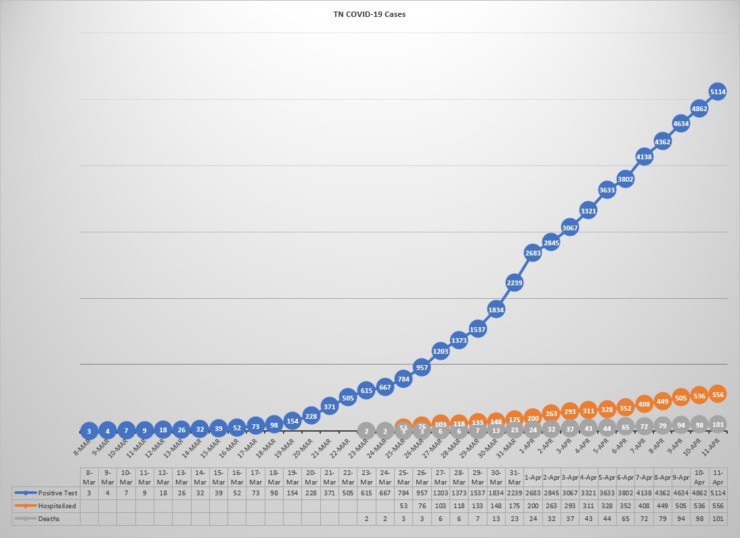
Note: This story was last updated at 2:45 p.m.
More than 5,000 COVID-19 cases have been reported in Tennessee, and more than 100 people have died, state health officials said Saturday.
The Tennessee Department of Health reported 5,114 cases and 101 deaths. The state health department publishes the state case totals at 2 p.m. Central time each day.
The largest percentage of COVID-19 continues to be among patients who are 21 to 30 years old. They account for 1,066 cases, or 21 percent of patients. That age group combined with four others (31-40, 41-50, 51-60, 61-70) account for 4,302 cases, or 83 percent of them.
The average age of COVID-19 patients in Tennessee has been 46. The age range of patients has been between 0 and 99.
COVID-19 is a contagious respiratory illness that can be deadly. In Tennessee, most deaths have occurred among patients who are 61 years and older. They account for 84 deaths, or 83 percent of fatalities.
In Tennessee, about 10.9 percent of patients who have tested positive or are presumed to have tested positive for COVID-19 have been hospitalized (556 of 5,114 cases). The state does not report which counties the hospitalizations occurred in, and it’s not clear how many of the patients remain in the hospital.
About 2 percent of patients have died (101 of 5,114 cases).
About 27 percent of patients have recovered (1,386 of 5,114 cases). The Tennessee Department of Health said recovered patients are those who have been confirmed to not have symptoms and have completed their required isolation period—or it’s been at least 21 days since they had their first test confirming their illness.
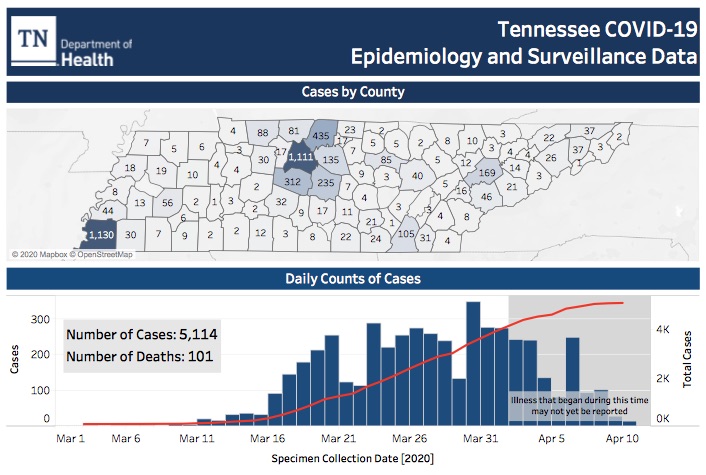
The number of cases in Anderson County ticked up by one to 12 on Saturday. One death has been reported in Anderson County, and nine patients had recovered as of Thursday.
Anderson County confirmed its first COVID-19 case on March 20. There have been 378 negative tests among Anderson County residents.
Since Thursday, April 2, the growth in the number of new cases in Tennessee has been at or below 10 percent. It had generally been higher than that before April 2.
The rate of doubling of cases appears to have slowed. The 5,114 cases reported Saturday was double the rate of cases reported about 10 to 11 days ago, between March 31 (2,239 cases) and April 1 (2,683 cases).
The number of deaths has doubled in about five to six days, between 44 on April 5 and 65 on April 6. That doubling period also appears to have lengthened slightly.
There have been 66,828 COVID-19 tests in Tennessee at the state public health laboratory and at other labs. The total number of COVID-19 cases in the state includes both confirmed cases and cases that are presumed to be positive. About 7.7 percent of tests in Tennessee have been positive, and roughly 92.3 percent have been negative.
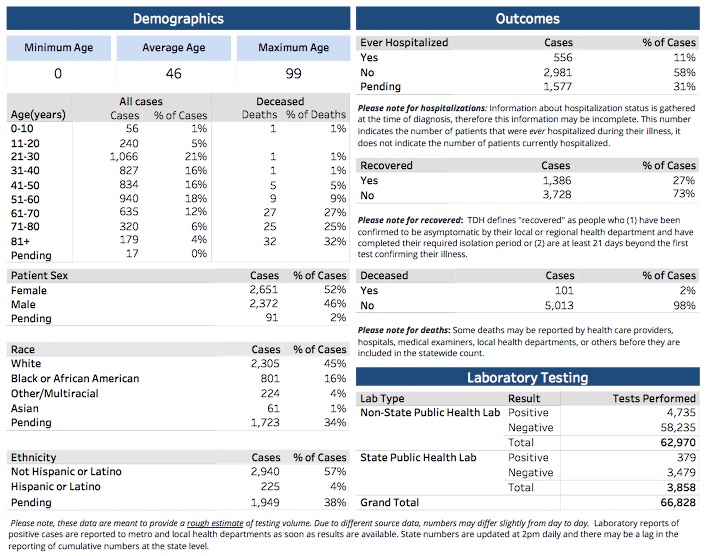
The Tennessee Department of Health has started including demographic information about COVID-19 cases in the state:
Gender
- Female—2,651 cases (52 percent)
- Male—2,372 cases (46 percent)
- Pending—91 cases (2 percent)
Race
- White—2,305 (45 percent)
- Black or African American—801 cases (16 percent)
- Other/multiracial—224 cases (4 percent)
- Asian—61 cases (1 percent)
- Pending—1,723 cases (34 percent)
Ethnicity
- Not Hispanic or Latino—2,940 cases (57 percent)
- Hispanic or Latino—225 cases (4 percent)
- Pending—1,949 cases (38 percent)
Symptoms of COVID-19 include fever, cough, and shortness of breath. In most cases, those who are infected with the new coronavirus that causes the diesase are not hospitalized and they survive. Still, even those who do not need to be hospitalized often report fevers, fatigue, headaches, trouble breathing, coughing, and chest and body pains that can sometimes last for days. Others report milder symptoms or no symptoms at all. But in some cases, somewhere around 20 percent or less, patients may need to be hospitalized, and some percentage of those patients need to be treated in intensive care and put on ventilators.
Older adults and patients with certain pre-existing conditions are reported to be more vulnerable to COVID-19. But health officials and health care workers caution that, while younger patients and those without pre-existing conditions might be less vulnerable overall, they can, for reasons that aren’t clear, still succumb to the disease—and might help spread the illness even if they don’t get sick.
COVID-19 is caused by a new coronavirus that was first reported in Wuhan, China, in December. Since then, it has spread around the world, infecting more than 1.8 million people and killing more than 110,000. There were more than 500,000 cases in the United States, where more than 20,000 people had died as of Sunday afternoon, April 12.
Across the world, the virus has led to quarantines and other disruptions to daily lives, including school and business closures; lockdowns and shutdowns; some hoarding and panic buying at grocery stores; travel bans and closed borders; and economic slowdowns and large number of job losses.
Globally, more than 410,000 patients were reported to have recovered from COVID-19 by Sunday afternoon.
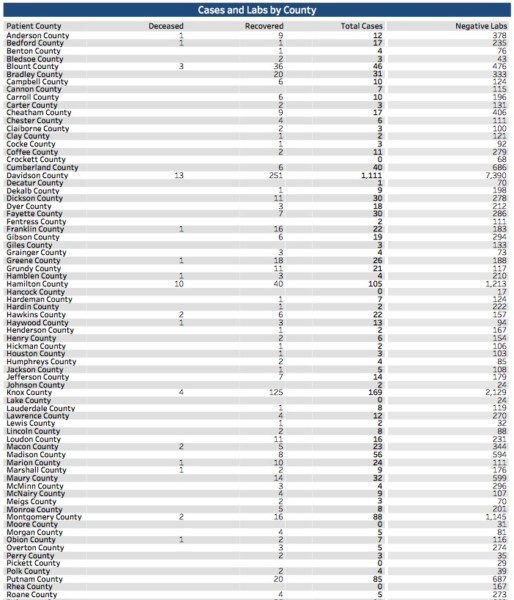
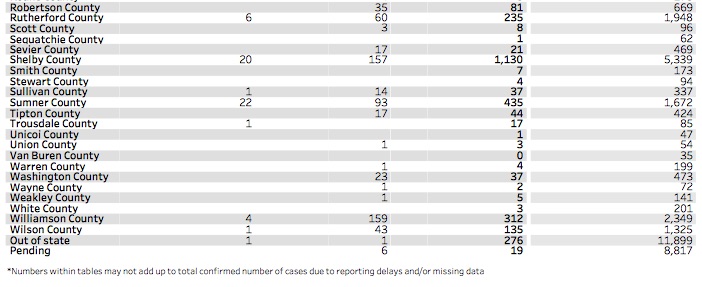
On Saturday, the state reported that 22 of the deaths from COVID-19 have occurred in Sumner County northeast of Nashville. There have been 20 deaths in Shelby County, which includes Memphis in West Tennessee, and 13 in Davidson County, which includes Nashville in Middle Tennessee. There have also been 10 deaths in Hamilton County, which has 105 cases and includes Chattanooga in southeast Tennessee.
Four deaths have been reported in Knox County, which includes Knoxville in East Tennessee. Knox County has had 165 cases, with 125 of those recovered on Saturday.
The other fatalities in Tennessee have been in Rutherford County (6); Williamson County (4); Blount County (3); Hawkins County (2), Macon County (2), and Montgomery County (2); and Bedford County (1), Franklin County (1), Greene County (1), Hamblen County (1), Haywood County (1), Marion County (1), Marshall County (1), Obion County (1), Sullivan County (1), Trousdale County (1), and Wilson County (1). One non-Tennessee resident has died.
Shelby County and Davidson County had more than 1,100 cases each on Saturday, with 1,130 in Shelby County and 1,111 in Davidson County.
Seven Nashville-area counties had 2,326 total cases on Saturday: Cheatham (17), Davidson (1,111), Robertson (81), Rutherford (235), Sumner (435), Williamson (312), and Wilson (135). That was about 45 percent of the state’s total.
Two Memphis-area counties in West Tennessee, Fayette and Tipton, had 30 and 44 cases, respectively. But it’s not clear how many cases might be in surrounding counties in Arkansas and Mississippi.
Besides Knox County, here were the case totals in other counties surrounding Anderson County on Saturday: Campbell (10, with six recoveries), Loudon (16, with 11 recoveries), Morgan (5, with four recoveries), Roane (5, with four recoveries), Scott (8, with three recoveries), and Union (3, with one recovery).
Leave a Reply